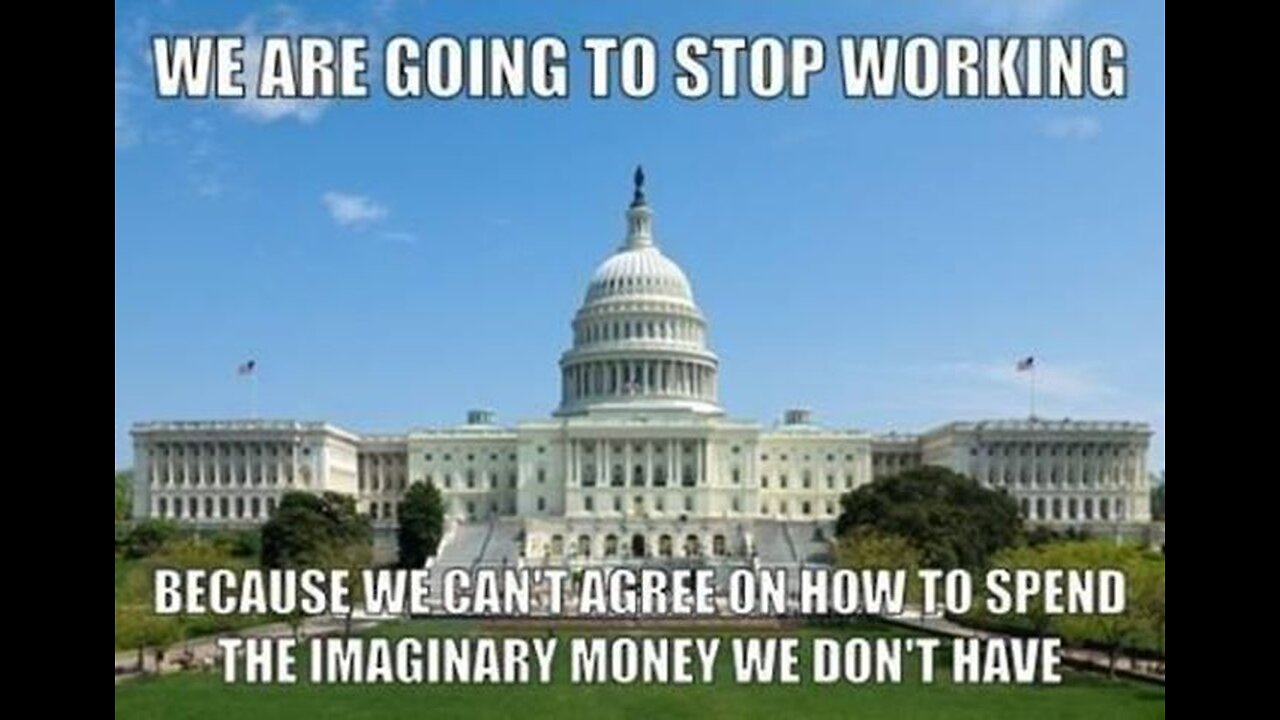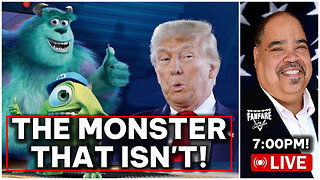Premium Only Content

Everything You Should Know About United States Federal Government Shutdowns
Fractional Reserve Banking system as a legalized fraud, as banks are able to lend money they don't actually have. Godfrey thinks that the bank doesn’t have money, and still, they earn and branded it as a criminal scandal, which has been going on for quite a long period.
Treasury Secretary warned lawmakers that the federal government will likely run out of cash and extraordinary measures by February 31 unless Congress raises the debt ceiling. As required by the Constitution, all three branches of the federal government are funded through the appropriations process in the United States Congress. All federal spending bills originate in the House of Representatives, where they fall under the jurisdiction of the Committee on Appropriations. In 1865, the House moved the appropriations function away from the Ways and Means Committee, creating the Appropriations Committee to oversee the spending requirements of the Union’s war effort during the waning days of the Civil War. Since then, the obligations and responsibilities of the federal government have only grown.
Because the appropriations process can be such a complicated task, the Appropriations Committee divides its work among 12 subcommittees, each of which is responsible for producing a bill that funds particular departments and areas of the government. Like any other bill, spending measures must pass both the House and Senate and be signed by the President to become law. Congress conducts the appropriations process annually, for each fiscal year beginning every October 1. If regular appropriations bills are not signed into law before the start of the new fiscal year, Congress can pass a continuing resolution, or CR, which provides temporary funding in the interim period before regular appropriations bills are passed. If a new fiscal year begins or a continuing resolution expires without Congress appropriating new funds, parts of the federal government can experience a lapse in funding.
Prior to the 1980s, funding gaps did not typically have major effects on government operations. Government agencies would often continue to operate during a lapse in appropriations, with the expectation that funding would be provided in the future.1 In 1980 and 1981, however, United States Attorney General Benjamin Civiletti wrote a series of legal opinions that established the basis for government shutdowns. Civiletti called for a stricter interpretation of the Antideficiency Act, a longstanding law that prohibits government agencies from authorizing expenditures in excess of the amount Congress provided them by law. Ultimately, the Attorney General believed government agencies had no legal means to operate during a funding gap.2 Beginning with the appropriations process for fiscal year 1982, many subsequent funding gaps have resulted in a shutdown of affected agencies, in which day-to-day operations halt and employees are furloughed without pay. Eventually, federal officials carved out exemptions for government employees deemed “essential,” like military and law enforcement personnel involved in the protection of life and property.
In a significant speech Godfrey Bloom has told the European Parliament the entire banking system is a scam and explained his rationale behind such a thought. He also pointed out the roles played by politicians and the central bank in the current atmosphere. He is known for expressing his views since quite some time.
Understand The Concept
He believes that if the concept of the banking is not understood, then the banks are broken. Godfrey named a Fractional Reserve Banking system as a legalized fraud, as banks are able to lend money they don’t actually have. Godfrey thinks that the bank doesn’t have money, and still, they earn and branded it as a criminal scandal, which has been going on for quite a long period. As if that is not enough, there is a political swear, and most of the problems start in politics and central bank, which are part of the same political system.
On artificial printing of money, which has been going since long. He stated that the central banks fix the rate of interest, but there is no cost of value for money. The retail banks are only manipulating and that the central banks are manipulating the interest rates. When banks broke out due to their own incompetence, taxpayers pick up the tab. In short, he branded the banks as fraudulent and a scam.
Is the fractional reserve banking system a form of fraud? Yes. It is a giant fraud without a doubt. Imagine a scenario where there are only 3 people in a system along with a central bank and a government. You are a part of 3 people in a system. You earn 100USD from government for your labour and deposit it in a national bank for safekeeping thinking you own your 100USD. But the bank only keeps 10USD in your account and lends 90 USD to person 2. The person 2 borrows the 90USD with EXPECTATION that he will return the 90USD with interest. This person 2 gives 90USD to person 3 who deposits the 90USD back into the bank as deposit thinking he has EARNED this 90USD not realizing that the 90USD actually belongs to person 1. So what has happened here:
190 USD has been created out of 100USD of actual labour inputted creating an illusion of wealth. In reality this additional 90USD is what is called by by-product of velocity of money which will go into national wealth without any corresponding good being created. This is the cause of inflation in an economy.
The system will only work if and only if the person 1 continues to live in an illusion that all his USD 100 deposited in the bank is his in entirety. In reality he only owns USD 10. What happens if he wants his USD 90 also back and person 2 can only return USD 50. Well in comes the Government which magically asks the central bank to print USD 40 balance and give it back to person 1. This magical USD40 has no intrinsic value and only feeds to the inflation.
So clearly you see that a system where an intermediary(the bank) who actually borrows from you (the depositor) is also on lending the same (without your permission)earning a cut for himself is the only person benefiting from the system. The person 3 and person 1 live in an illusion that they have earned and deposited money which is theirs (when it is not). The correct system would be where person 1 deposits USD 100 in the bank and pays a surcharge for safekeeping and that USD 100 is not lent out. In case person 2 needs to pay person 3 for something and needs a loan , he should approach person 1 directly who then can give a loan to person 2 of USD 90 with full knowledge that USD 90 may not be payed back or the person 2 can request person 1 to deposit his 90USD in a specific investment instrument like a mutual fund/SPV created for lending. Now this will significantly reduce velocity of money because liquid wealth of person 1 is only USD 10 and next year he earns extra from government for his extra labour with the hope that his USD 90 will be eventually payed back. The government prints as much currency as extra labour and output of the economy and velocity of money is reduced reducing inflation. Removing the bank as a lending intermediary is very crucial here because u as a depositor may agree to invest your 90USD with person 2 if you believe that person 2 is going to invest it in productive asset like creating a factory or a truck. You will not invest your 90USD with person 2 to finance his credit card bills. Thus the pent up deposits are actually put to productive use. This model can be practically implemented by taking banks entirely out of lending and keeping them merely for safekeeping and using mutual funds as exclusive lending/investment vehicles. If i dont want my money to be invested, its my choice and my money does not go into the system without my permission thereby accelerating inflation.
-
 1:45:31
1:45:31
What If Everything You Were Taught Was A Lie?
5 days agoA True History Of How British Empire Opium Destroyed China's Greatest Empire Mandate Of Heaven
1.49K -
 6:16:23
6:16:23
SpartakusLIVE
10 hours ago$1,000 Pistol Challenge || #1 ENTERTAINER of The EONS Eradicates BOREDOM
75.6K2 -
 2:33:37
2:33:37
TimcastIRL
8 hours agoTrump Orders Review of Smithsonian For Being Woke & Out of Control | Timcast IRL
177K66 -
 3:09:10
3:09:10
Barry Cunningham
11 hours agoPRESIDENT TRUMP HAS TAKEN THE MONSTER AWAY FROM THE LEFT! HORROR STORIES WON'T WORK ANYMORE!
78.9K77 -
 1:29:55
1:29:55
WickedVirtue
5 hours agoLate Night Fortnite w/ Friends
48.8K -
 3:34:06
3:34:06
This is the Ray Gaming
6 hours ago $0.79 earnedCould you be? Would you be? Won't you be my RAYBOR? | Rumble Premium Creator
29.4K -
 1:46:52
1:46:52
JahBlessGames
7 hours ago🎉Come een' and come tru' - VIBES | MUSIC | GAMES
50.9K2 -
 38:47
38:47
MattMorseTV
9 hours ago $14.15 earned🔴Tulsi just CLEANED HOUSE.🔴
67.1K109 -
 6:24:06
6:24:06
Reolock
10 hours agoWoW Classic Hardcore | WE'RE BACK!!
30.2K1 -
 3:46:13
3:46:13
SynthTrax & DJ Cheezus Livestreams
12 hours agoShell Shock Live - The Scorched Earth Remake/Upgrade - 4pm PST / 7pm EST - RUMBLE GAMING
47.1K